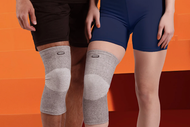Discover the many benefits of rucking and how to do it safely. Plus, find out why it's the best workout for busy professionals with limited free time.
Discover the many benefits of rucking and how to do it safely. Plus, find out why it's the best workout for busy professionals with limited free time.
Sitting at your desk all day got you stiff as a board? Or maybe you don't have much room in your schedule to fit in some much-needed exercise.
Well, rucking might be the solution you need right now.
It's walking with purpose and weights. It transforms an ordinary stroll into an intense workout that will make you stronger and more capable overall. Keep reading to learn everyone you need to know about it.
Rucking is a military exercise that involves walking with a weighted backpack. It's an accessible and time-efficient strength and cardio workout that can:
It can also be done almost anywhere and anytime, so it's great for busy pros.
Rucking is walking or hiking with a heavy backpack (or a rucksack) for an extended period. The weights in the backpack can be anything from sandbags and rocks to weighted plates and other heavy objects.
It's been a staple of military training workouts worldwide, where soldiers have to carry heavy packs containing weapons, ammunition, food, water, and more for many miles at a time. This helps improve their muscular strength and cardiorespiratory fitness.
Recently, rucking has grown beyond its military roots and gained popularity as a fitness activity. It may seem easy, but that the simple act of walking or hiking becomes significantly more challenging when carrying a weighted pack.
The added resistance forces the muscles—especially the ones in the legs, hips, and back—to work extra hard with each step. This turns an ordinary walk into an intense cardio and full-body strength training workout.
Rucking is a simple exercise that doesn't require any fancy equipment, and you can easily improvise the weights in your rucksack.
You only need:
Proper form is key when rucking to avoid injury. Your shoulders should be back and down, not rounded forward. Also, you should keep your chest up while rucking.
Your backpack should sit high between your shoulder blades for support. Wearing it too low can tire you quickly and maybe even injure you.
"Head up, eyes forward" is the motto when rucking. You need to be looking ahead as naturally as possible. You can't be craning your neck forward or down.
You should also be taking smaller steps than usual to accommodate the load. Please don't over-stride; it won't make you any stronger.
Last but definitely not least, you have to prioritize foot care. Trim your toenails to prevent black toes, and make sure to put on moisture-wicking socks before going out for a ruck.
Everyone is talking about rucking because of these impressive benefits:
Rucking is as convenient and accessible as can be. No gym membership and no elaborate equipment; just a basic backpack, some weights, and you're good to go.
You can ruck anywhere—on hiking trails, in parks, or around your neighborhood—and you can fit a rucking workout into a busy schedule—before work, on lunch breaks, or in the evenings.
Running is often cited as the best cardio exercise, but it can be really hard on the feet, knees, and hips. It can sideline even the most careful runners.
In contrast, rucking is safer due to the slower walking pace. The gradual weight bearing helps build bone density while being gentle on the joints.
Weighted walking can be done daily as a form of active resistance training, especially for those with desk jobs. The lower impact means most people can ruck well into older age.
You can calculate approximately how many calories rucking will help you burn using a rucking calorie calculator, but generally speaking, it can burn up to 3x more calories than walking.
Though rucking may not burn as many calories as running, it's close. Besides, it's better at burning fat and preserving muscles. It helps you avoid that skinny-fat look running can sometimes render.
The weight, distance, and pace can be dialed up or down to match your goals and current physical ability.
For beginner ruckers, a 10-pound load and 2-mile distance is suitable. Experienced ruckers may go for long treks of over 10 miles while carrying 50 pounds or more.
Ruck marching is an exercise that combines strength and endurance. Doing it correctly helps balance your body composition and turns you into a machine.
If you're thin and wiry, rucking can help you with muscle development. If you're not happy with your body weight, heavy-load ruck workouts can help you trim that excess weight over time.
Here are a few other noteworthy benefits of rucking:
If you're struggling to work up a sweat and keep your body in shape, you're going to love rucking for the following reasons:
Just because rucking is a low-impact exercise doesn't mean it's completely risk-free. To avoid injuries and get the most out of rucking, adhere to these best practices:
If you're a busy professional looking for an accessible and time-efficient workout to keep you in shape, look no further than rucking. Strapping some weight on your back and going for a walk may sound too simple, but it can deliver great results.
Not only will it improve your muscular strength and cardiovascular fitness, but it'll also increase your energy levels, mental clarity, and creativity.
So what are you waiting for? It's time to start rucking!

Incrediwear is on...
September 25, 24

Pain management i...
September 23, 24

Recovery wear is ...
September 12, 24